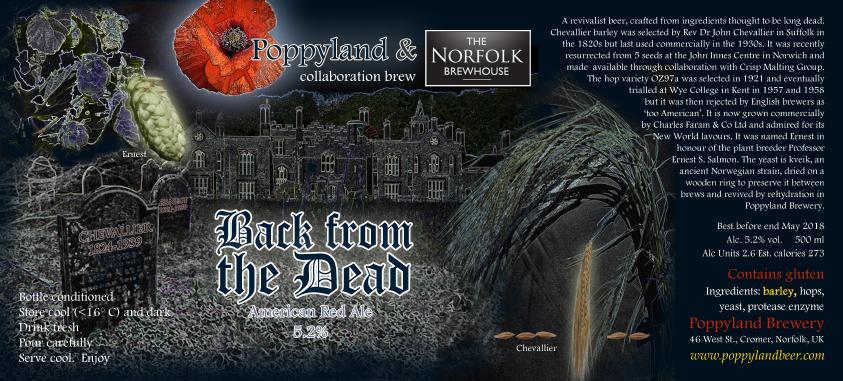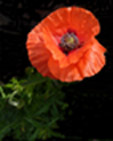Back from the Dead
Collaboration with David Holliday of Norfolk Brewhouse. Bottle conditioned American red ale, 5.2% abv, in 500 ml bottles, crown capped.
Release date 30 July 2017.

Brewed on: 20.4.2017 Bottled: 6.7.2017.
The idea to brew this beer was David Holliday's. He was able to obtain the star ingredients: Chevallier Heritage Malt from Crisps and Ernest hops from Charles Faram & Co Ltd. The malt was first selected by Rev Dr John Chevallier in Suffolk in the 1820s and has been the malting barley of choice throughout the remainder of the 19th century and well into the 20th but it was eventually usurped by new varieties that gave the farmer better yields, shorter straw and barley that didn't lodge (fall over) so readily. It lasted commercially into the 1930s. It was recently resurrected at the John Innes Centre in Norwich and made available through a collaboration with Crisp Malting Group.The hop variety OZ97a was selected in 1921 at Wye College in Kent but was not trialled until 1957 and 1958. When it was offered to some British brewers they rejected it for being rather harsh and too American. Since 2014 is has been grown commercially by Charles Faram & Co Ltd and admired for its New World flavours. It was named Ernest in honour of the plant breeder Professor Ernest S. Salmon.
So, two key ingredients that have come back from the dead are at the heart of this beer: one from two centuries ago and one from one century ago. No one thought they wqould be able to use these ungredients uyntil they were unexpected revived. The Norfolk Brewhouse brewed 10 barrels of their version at 5% strength and sold it in cask during the Norwich City of Ale Festival 2017. The Poppyland version was aimed to be 6%, and reddened with some black and a touch of chocolate malt. However, things didn't go to plan.
Being more of a risk taker at Poppyland than a large brewhouse dares to be I decided to brew with a third ingredient that has been revived - traditional 'kveik', a yeast that has passed down through generations of farmers and village brewers in the west of Norway literally for centuries. In-between brews, in the days before refrigeration, they stored the yeast by drying it on the rough surface of a log (kveikstokk) or a block of wood or later on on an elegant puzzling ring of wooden pegs all linked together in a circle like a daisy-chain.
The Poppyland fermentation started well enough at 1058 and developed a high krausen but then it slowed down to a crawl. I roused it several times, adding air to encourage yeast growth, but it was slow, reaching only 1030 after almost a fortnight. Eventually I was forced at add fresh yeast - Mangrove Jack's M44 California Ale yeast to finish the job. It limped down to a gravity of 1020. My assumption was that the kveik was not vibrant enough and/or under-pitched but I have heard from other brewers that Chevallier has a tendency to stall in fermentation and only slowly gets down to terminal gravity. The flavour was rather odd and I was concerned that during the slow fermentation and rousing the brew had become infected with wild yeasts or bacteria and after almost a month I was considering dumping it. But a conversation with Shane Swindells of the Cheshire Brewhouse persuaded me to persevere. So I bottled a single kilderkin and placed the rest in wood - a 225 litre French barrique - to age with Saccharomyces (formerly Brettanomyces) bruxellensis (Trois). If it turns out well, the result - a drier and mildly funky beer - will be well and truly Back From The Dead. Otherwise it's a drain pour (only joking, Anglian Water).
Norfolk Brewhouse's fermentation went okay but David tells me that the Chevallier under-recovered, producing less wort of the required strength than predicted by the maltings.
The name of the beer came to me thinking about the revival of the ingredients but it also resonated with my mood. In the autumn I was in low spirits as my eyesight failed and hips, feet and knee pained me and my brewing activity declined as a result. By the spring I was coming out of it - blind in one eye - but feeling much more positive. See this blog for more on that. As I told David, I had got my Mojo back.
Label imagery
The background image is the Gothick pile of Cromer Hall very close to Poppyland Brewery and the gravestones are in the town cemetery up the Holt Road. The hop is an English hop in my garden modified to what I am guessing Ernest looks like but the stook of barley really is Chevallier that I photographed at Gressenhall Farm and Workhouse at an event attended by the John Innes Centre back in 2013. The five seeds represent the five humble seeds that were withdrawn from the gene bank at John Innes and grown on and further selected to become the modern generation of Chevallier Heritage Barley malted by Crisps.
Tasting notes
Certainly a very novel flavoured beer and I am glad I saved it. Most of this is due to the distinctive flavour of the Ernest hop and the richness of the Chevallier malt but maybe there is a twang from the fermentation: whether that be the kveik or other organisms I am not sure. In bottle the fermentation is stable (i.e. not over-conditioning so far, even in high summer temperatures) and it has dropped fairly clear. I love it for its organoleptic qualities although some people may not (perhaps thinking, like those British brewers of the 1950s, rather harsh and too American!). Cheers.
Gluten free status
Contains gluten.
Martin Warren, The Poppyland Brewer
 Poppyland Beer
Poppyland Beer